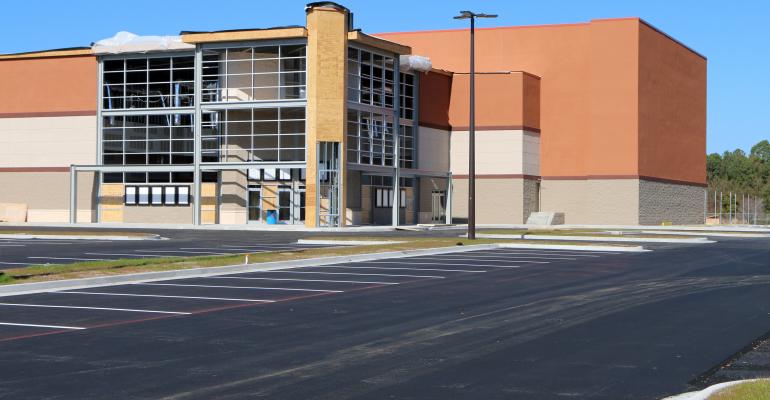As the retail industry continues with its metamorphosis, talk has turned to what will happen with all that extra big-box and mall anchor space that’s coming on the market?
From 36 to 37 million sq. ft. of retail space could be returned to the market by next year, according to a recent report by JLL Research, based on store closure announcements.
The next occupiers of the vacated spaces run the gamut, sources say, from specialty retailers to service providers to entertainment concepts to industrial and office tenants.
“Retail real estate is undergoing an entrepreneurial moment like never before. It’s a blank slate and there’s no cookie cutter,” says Jedd Nero, executive managing director of retail services at commercial real estate services firm Avison Young. But because this is a new phase in the retail real estate sector, the effect on rent rolls and ROI of these new strategies is difficult to predict, he notes.
There’s “no crystal ball on how long this metamorphosis will take, and no timeframe that has to be met,” Nero says.
Some anchor space is getting repurposed as charter schools, community colleges and call centers, according to Edward Dittmer, of Morningstar. The benefit to incorporating a non-retail use is that it brings people in during the day, when the mall is usually not as busy. They could step into the mall and shop, though not on a regular basis, he adds.
Vacated anchor stores are also being separated into smaller spaces, in some cases to be occupied by non-mall retailers, says Dittmer, citing Whole Foods as one example.
Retail big boxes could work as multifamily housing, says Rick Chichester, president and CEO of real estate investment advisory firm Faris Lee Investments. Call centers can also work, especially since landlords would have to put less money into repurposing the property. “We are seeing some retail being converted to seniors care,” Chichester adds. The approach can work well because active seniors need convenient access to shopping and services that are present at retail centers.
Medical office space is another contender in the non-retail tenant category. At Hudson Valley Mall in Ulster, N.Y., integrated healthcare system Health Quest will take the 81,000-sq.-ft. space left behind by a shuttered Macy’s and turn it into a medical center.
“Some non-retail tenants we are seeing enter anchor space are data decenters, housing, distribution centers and offices. You don’t get good clear heights for warehouse space, but the space works great for staging as a last-mile distribution center,” says James Cook, director of retail research for JLL.
Retail and distribution space are poised to converge, according to Fitch Ratings, as retail centers and last mile distribution facilities for e-commerce essentially serve the same purpose. “If the alternative is an antiquated or failing center in a municipality, zoning authorities and their communities will eventually be compelled to consider zoning changes allowing small-scale distribution facilities at current retail zoned sites,” Fitch analysts write. As part of this convergence, infill retail locations could become retail distribution facilities serving as delivery and pick-up locations.
“What the convergence means for rents on an absolute basis remains to be seen. That said, one scenario is that rents decline while utilization of property lot square footage increases,” says Chris Pappas, director at Fitch Ratings.
When malls and shopping centers do repopulate empty anchor or big-box space with other retailers, the tenants will most likely fall into the categories of food, fast fashion and entertainment, according to Cook.
Experiential tenants typically pay a higher rent, according to Steve Jellinek, of Morningstar. Examples of experiential tenants looking at space at malls include Legoland and the Crayola experience store. “GGP is opening Kidzania outlets in some of its malls, such as in Oakbrook, Ill. and Dallas. There is also Sea Life, a small chain of aquariums that has moved into the big-box space in six to seven malls. But all of those uses come at pretty significant costs,” Jellinek says.
Landlords are looking at what appeals to shoppers in the local markets in order to bring in the most appropriate tenants, according to Nero. “There’s emphasis on food halls and grocery stores because that’s what brings people in,” he says.
How the leases are structured and the resulting effect on total rent rolls and ROI are decisions that will be based market-to-market, sources say. “In a rapidly changing retail world, lenders, investors and operators will have to refocus their attention to demographics. When it comes to last mile retail distribution, underwriting on location (based on consumer demographics) may take on as meaningful importance as in-place NOI,” Fitch analysts write.
Anchor space has normally been leased at such low rental rates that in most cases, even with tenant improvement (TI) dollars, landlords can make a good return, according to Cook. But in regards to alternative tenants, “not everyone has figured it [financials/lease terms structure] out yet.”
For instance, in some cases office users could pay market rate, while in others they might insist on being below market. “Below market office rent is still a good deal for all parties involved. Even new retail tenants coming in—what they pay is a great improvement over the legacy anchor rents,” Cook says.

